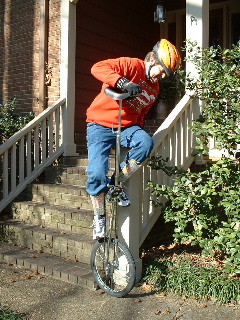Re: Giraffe and physics
Bravo!!! … Bravo!!! Extremely well said!
Mikefule is a brilliant light in an otherwise pitch black night of
boring posts to RSU. He isn’t the only brilliant author on RSU, but
I simply had to give him this public recognition at this time.
Thank you very much for the quality posts, a good example of which is:
>The centre of mass of giraffe and rider is pretty high up - probably
>somewhere in the rider’s lower abdomen. The centre of support is where
>the wheel touches the ground. All movement of the giraffe is caused
>either by gravity acting on the centre of mass, or by the tyre pushing
>one way or another on the ground.
>If you throw a yard brush (broom) so that it spins end over end, it will
>rotate around its centre of mass - somewhere in the handle, a short
>distance from the head.
>So if you threw a giraffe and rider so that the unit span end over end,
>it would rotate around the centre of mass (rider’s abdomen).
>What this all means is that it’s very easy to move the light wheel and
>quite difficult to move the heavy rider. If the rider were completely
>rigid (say with fear;) ) then the wheel would move easily, and the rider
>would rotate around his/her abdomen - unless of course the rider was
>already ‘falling’ under the influence of gravity. So that’s why the
>wheel easily scoots out from under you. On a normal uni, the centre of
>mass is much nearer to the wheel. It’s still easier to move the wheel
>than the whole mass, but not as much easier as it is on a giraffe.
>Riding a unicycle is like being in orbit. You keep falling under
>gravitational acceleration, but you never hit the ground. The
>difference is that in orbit, the ground cunningly curves away from you,
>and on a uni, the wheel should chase after you, balancing the lift
>against gravity. I’m surprised NASA don’t sponsor unicycle.com, really.
Sincerely,
Ken Fuchs <kfuchs@winternet.com>
P.S. Let me set the record straight on an old somewhat unrelated thread:
Mikefule is definitely right about steering control being largely
transmitted through the pedals/crank arms as this is particularly true
of big wheels, especially those with axel widths greater than the Coker.

